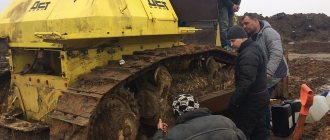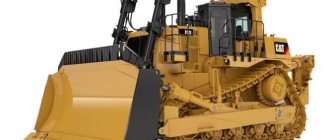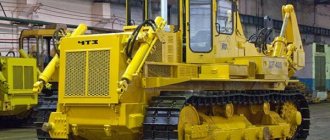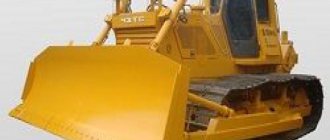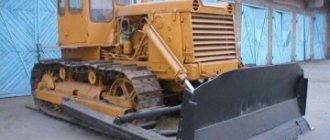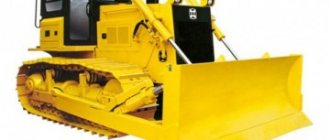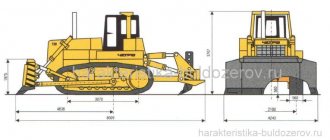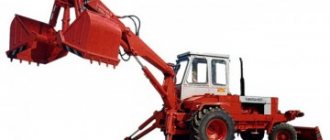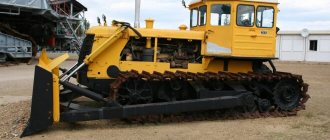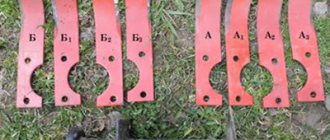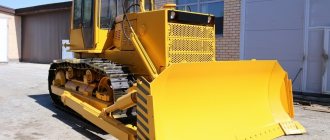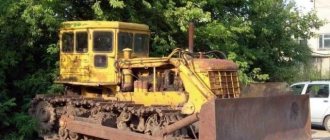The T-330 model was developed by the Industrial Tractor Plant (Cheboksary) and is the only model in its category mass-produced since 1975. Active operation of the unit began in the early 80s - it was preceded by a series of modifications, after which the tractor was recommended for industrial use .
Model history and design features
In the early 70s of the twentieth century, a number of large-scale projects were actively implemented in the Soviet Union - for the laying of oil and gas pipelines;
railways, large industrial facilities, field reclamation. The need for powerful, energy-rich equipment up to the 25th traction class has increased significantly. Developed in 1972-1975, the T-330 became a worthy replacement for similar imported equipment previously purchased for hard currency from the Caterpillar, Komatsu, and Liebherr concerns. The task was to stop subsidizing foreign economies by buying the necessary equipment for foreign currency, and start its own production.
Since the T-330 was created as an alternative to foreign energy-rich technology, it was naturally developed with an eye on these samples. But there was no exact copying of components and parts. As a result, the bulldozer turned out to be somewhat inferior to its famous counterparts in terms of performance. However, the cost of its production and further maintenance was several times lower.
As conceived by the designers, the T-330 was to become not only a heavy industrial bulldozer, but also the lead model, the basis for a new family of industrial tractor platforms, including machines of various traction classes with a single layout; unified by units and mechanisms. In addition to its main use in cutting and moving soil, the T-330 was intended to become the basis for the creation of a number of units that carry attachments: cranes, excavators, and pipe-laying equipment.
It must be said that this powerful tractor attracted increased attention from the media, public organizations and foreign experts long before its mass distribution in the country. The reason for this was the new, unusual design of the model, atypical for standard bulldozer tractors. Among specialists (not only foreign, but also Soviet) it caused mixed reactions and real controversy.
At the first glance at the T-330, one was immediately struck by its unusual and even layout. The operator’s cabin, by the will of the designers, was moved far forward and installed almost close to the back side of the blade. She literally hung right over the dump. This is especially evident on bulldozers of early production series.
During control operation in the city of Cherbakul, Chelyabinsk region, it was revealed that rock, when excavated by a bulldozer, could accumulate on the dump, and then fall over the canopy, ending up on the front part of the cabin. And if the work was carried out on rocky soils, this could lead to damage to the front glass and the cabin itself. It was not possible to completely secure the cabin by installing a grill made of welded rods.
As a result, later on the production versions the cabin was moved back a meter, and an armored hood with the logo of the Cheboksary Industrial Tractor Plant was installed in front of it. But even after the described modification, the T-330 was still significantly different in its bold appearance from the standard bulldozer models of that time.
The idea to implement this unusual layout option was due to the following fact. The main “working tool” of a tractor-bulldozer is a bulldozer blade, suspended from the front. With a standard layout behind the massive hood of a powerful and voluminous engine, the operator simply does not have the opportunity to see the working process in all its details.
This negatively affects his fatigue and reduces his overall work efficiency. And on some powerful bulldozers, the operator generally had to work standing in those days. Therefore, the decision of Soviet designers to move the cabin forward turned out to be truly bold and justified. It made it possible to improve visibility, and, consequently, indicators of work accuracy and safety.
In the modern era, the T-330, already under the name CHETRA-T25, continues to be produced at the Cheboksary Tractor Plant, which is part of the Promtractor holding. However, this modern analogue of the T-330 - the CHETRA T25 bulldozer - uses a QSX15-C440 diesel engine, from (in a number of batches - the Yaroslavl YaMZ-8501.10), and pump units.
Description of special equipment
The bulldozer has sufficient power, has a margin of reliability, and is characterized by low repair costs. Its main drawback: the engine is unable to operate efficiently for many years.
A major overhaul is not always able to fully restore factory functionality, which is why some types of special equipment are equipped with imported engines. The modernization of the tractor, carried out after forty years of use, ensured an increase in the survivability of problem units.
Dimensions of bulldozer T-330
As a result, a powerful motor has been developed that has an alternative between liquid or air cooling. It is more efficient when operating in summer or winter.
Purpose
The purpose of the T-330 is to carry out construction, repair and reclamation work in a wide range of temperatures (from -50? C to +50? C). It seems most effective to use a bulldozer to implement large projects, allowing you to achieve the optimal ratio of work performed to maintenance costs.
The standard equipment of the tractor includes a ripper and a front transverse blade. The hood of the structure is armored, has increased strength and eliminates deformation when moving a large mass of hard rocky soil. The forward location of the cab reduces the load on the operator, opening up greater visibility when working with the front blade. To reduce the likelihood of damage to the cab by soil coming from the front of the bucket, it was moved slightly back (under the protection of the hood).
Increasing the practical efficiency of a crawler bulldozer for working on frozen surfaces is achieved due to the possibility of discharging exhaust gases under the dump. This prevents the freezing of soil conglomerate, which reduces the mobility of the bucket and the mass of the material being moved.
Thanks to an effectively implemented air cooling system, the engines are designed for cold starts at low temperatures. In hot weather, cooling is sufficient to prevent overheating that occurs during intensive work. Models equipped with liquid cooling are most effective at high air temperatures.
Specific examples of the industrial use of tractors include:
- preparation of soil for the foundation of large buildings;
- participation in the destruction and dismantling of reinforced concrete coverings;
- clearing pits;
- liquidation and prevention of the consequences of natural disasters (clearing ditches, making embankments, removing construction debris).
Application area
Important! The bulldozer is designated by specialists as T-330Р1-01. The unit is used for layer-by-layer removal of soils of I-IV density categories, leveling the territory of the working site.
The T-330 is used for overburden of rocks in open-pit mining, in the construction of industrial facilities, and in road work.
Purpose of the unit:
- removing soil from the surface of the site in layers and moving the soil mass, gravel, crushed stone and other material across the working area;
- backfilling a excavation, pit, trench, etc.;
- leveling the surface of the working site in accordance with the design marks;
- construction of embankment dams, construction of dams, solid foundations for road surfaces, etc.;
- stacking and mixing of non-metallic building materials;
- construction of pits for foundation elements;
- cleaning the territory of construction sites, uprooting bushes and small forests;
- snow removal, elimination of the consequences of ice conditions.
Specifications
Most modern T-330 models are equipped with a modern 12-cylinder engine, since the working life of old 8-cylinder units has almost always been exhausted. Here are the characteristics of the bulldozer in the configuration most often found on sale or as part of mechanized units.
Engine of the bulldozer T-330 (version YaMZ-240NM2, Yaroslavl):
| Characteristics | Indicators | Unit measurements |
| Cylinders: | 12 | PC. |
| - number | 130 | mm |
| - diameter | 22,3 | l |
| — working volume | 140 | mm |
| — piston stroke | ||
| Power | 368/500 | kW/hp |
| Shaft speed | 2100 | rpm |
| Torque (maximum) | 1815/185 | N?m/kgf?m |
| Fuel consumption (minimum) | 208/153 | g/h per unit of power (kW/hp) |
| Dimensions | 1,760 ? 1,100 ? 1,190 | m |
| Weight | 1,790 | T |
Dimensions and characteristics of tracks:
| Characteristics | Indicators | Unit measurements |
| Shoes: | ||
| - number | 42 | PC. |
| - width | 650 | mm |
| Link: | ||
| - step | 250 | mm |
| — height of engagement with the ground | 90 | mm |
| Contact area | 7,86 | m2 |
Hydraulic system parameters:
| Characteristics | Indicators | Unit measurements |
| Pumps | Gear | — |
| Performance at 1700 rpm. | 430 | l/min. |
| Pressure relief valves: | ||
| - ripper | 160 | kg/cm2 |
| - blade misalignment | 160 | kg/h2 |
| - dump | 160 | kg/cm2 |
| Piston parameters (diameter, stroke): | ||
| — hydraulic cylinder for raising and lowering the blade | 160x1250 | mm |
| - blade misalignment | 220x300 | mm |
| — lifting the ripper | 220x560 | mm |
Driving performance:
| Characteristics | Indicators | Unit measurements |
| Length | 9330 | mm |
| Height | 4762 | mm |
| Width | 4230 | mm |
| Specific pressure | 1,127 | kgf/cm |
| Tank volume (diesel fuel) | 670 | l |
| Speed range: | ||
| - forward | 0-17 | km/h |
| - back | 0-14 | km/h |
| Weight | 54800 | kg |
| Ground clearance | 0,57 | m |
Bulldozer and loosening equipment:
| Characteristics | Indicators | Unit measurements |
| - type | hemispherical | — |
| - width | 4860 | mm |
| - height | 1820 | kg |
| — lifting height | 1530 | kg |
| - deepening | 650 | kg |
| - weight | 7030 | kg |
| Drawing prism | 13 | m3 |
| Blade depth | no more than 0.65 | m |
| Blade misalignment | ±12 | hail |
| Ripper: | ||
| - type | parallelogram | — |
| - number of teeth | 1 | PC. |
| — lifting height | 950 | mm |
| - deepening | 1380 | mm |
| — range of loosening angles | ±14 | hail |
| - weight | 6489 | kg |
| An effort: | ||
| - deepening | 15300 | kg |
| - deepening | 56400 | kg |
The cost of modern versions of a bulldozer reaches 5 million rubles. Older and worn-out models are cheaper, but their maintenance costs raise the price almost to the level of modern models. A significant advantage when using a bulldozer is lower costs for spare parts than for foreign analogues.
Engine
At production, the T-330 was equipped with a 22.6-liter 8-cylinder 4-stroke diesel engine “8DVT-330A” , produced by the Volgograd Motor Plant. The power of this V-shaped turbocharged power plant is 250 kW / 330 horsepower. (By the way, this indicator is where the name of the tractor “T-330” came from). The cooling system is air, not liquid, well suited for working in the Far North and similar harsh climatic zones.
- The cylinder diameter and piston stroke of the 8DVT-330A engine are 150×160 mm;
- rated speed (torque) – 1,700 rpm;
- specific fuel consumption – 230 g/kW.hour; high pressure fuel pump - “Bosh” (Germany), “Motorpal” (Czechoslovakia) or “YAZDA” (Soviet Union);
- the maximum traction force of the T-330 bulldozer with the 8DVT engine is 670 kN / 68.2 tf;
- the weight of the 8DVT-330A engine is 2.6 tons.
The engine is located in the middle part of the tractor, behind its cabin.
In fact, with intensive use, the 8DVT engine served (at best) no more than 3 years, after which it required major repairs. The total resource of this engine was no more than 3-4 thousand hours. During the overhaul of the 8DVT engine, all defective components and parts were replaced; grinding the crankshaft to the nearest size or replacing it; installation of new liners, piston rings; setting up and adjusting fuel equipment; replacement of all seals, rubber goods; installation of new harnesses, sensors; replacement of starter ST-721, generator 11.3701.
In the “dashing nineties”, the Volgograd Motor Plant (like many other enterprises in Volgograd, and other cities) was subjected to total ruin and looting, and this engine model “decided to live a long time.” Therefore, many bulldozer owners found a way out of the situation by replacing the 8DVT-330A engine, which had completely exhausted its service life, with the BelAZ YaMZ-240 NM2 engine. The few “T-330” tractors that have “survived to this day” and “remained in service” are, for the most part, equipped not with their “native” Volgograd engine, but with the Yaroslavl “YAMZ-240”.
Transmission
The transmission of the T-330 crawler tractor deserves special mention. The bulldozer is one of the few modern Russian-made units with a hydromechanical system. A modular suspension of a separate type is connected to the crawler track. To operate the system, a three-wheeled single-stage torque converter of an integrated design is used, supplemented by a centripetal turbine.
The maximum transformation ratio is 3.0. The design uses wheels with a diameter of 480 mm. The efficiency of the installation is 0.906. All of the above indicators create ideal conditions for the most efficient use of engine torque, and also ensure its stepless regulation depending on the level of load on the machine.
The hydromechanical transmission of the T-330 bulldozer uses a three-stage, six-shaft, fully reversible gearbox. The functioning of the checkpoint is ensured:
- helical gears of constant mesh;
- disc hydraulic clutches;
- reversible brake control mechanism;
- band stopping brake system;
- reverse brake system for each side (the brakes are combined into one autonomous unit);
- matching gearboxes of mechanical transmissions for each side.
Cardan transmissions are used to transmit torque to bevel gearboxes. The hydromechanical transmission provides a bifurcation of the power flow to the drive wheels, guaranteeing parking of the machine on any plane due to the movement of the tracks in different directions.
A transmission system of this type has a number of advantages:
- efficient use of engine torque and power at any speed;
- development of maximum traction in all modes, including support mode;
- easy maneuvering in cramped conditions due to the separation of the track drive.
Interesting fact: the torque converter of the T-330 tractor is based on a similar unit from a diesel locomotive.
Travel mechanism
The running system of the T-330 bulldozer consists of two five-roller tracks suspended on the final drive axle. Five support rollers and two support rollers on each side ensure the movement of the machine. The torsion bar suspension of the rollers increases the smoothness of the tractor, ensures constant adhesion of the tracks to the surface and reduces dynamic loads on the chassis. This allows you to use maximum traction force and increase cross-country ability even in difficult conditions.
To ensure the operation of the running system, a “perpetual” lubrication system is used. The tracks are tensioned using a hydraulic drive, which makes working with the equipment easier.
Travel mechanism
This tractor's undercarriage system is equipped with two tracks that support five rollers. They are suspended along the same axis with final drives. Additionally, there is a pair of support rollers on each side.
The suspension of these supports is torsion bar, in order to increase the smoothness of maneuvers, guarantee traction between the tracks and the ground, and reduce dynamic loads on the mechanism. Thanks to this design, the traction force is fully used and maneuverability is increased.
To achieve long-term operation of the chassis, a “perpetual” lubrication system has been developed. The tracks are in constant tension thanks to a hydraulic drive - this makes it easier to control the equipment.
Device
Initially, the car was equipped with an 8-cylinder air-cooled engine. The V-shaped cylinder arrangement increases compactness and allows you to make the most of the diesel engine's capabilities.
Modern versions of the bulldozer (modernized) are equipped with 12-cylinder engines produced by the Yaroslavl Motor Plant. The main advantage of such enhanced versions is increased power, increasing productivity.
The main components of the tractor and their parameters are as follows:
- The cabin is a two-seater cabin, equipped with forced ventilation and heating, as well as modern air conditioning. Double-layer glazing of the cabin increases its thermal protection in any temperature conditions and prevents freezing. The cabin has extra cushioning, ergonomic seats and smart controls.
- Hydromechanical transmission - equipped with a three-speed, fully reversible gearbox that separately transmits torque to both sides. The braking system also operates separately, which, together with the reverse, ensures the maneuverability of the bulldozer in a confined space (allows it to turn on the spot).
- The torque converter, which includes impellers with a diameter of 480 mm, has a high efficiency for this type of structure - 0.906. The maximum transformation ratio does not differ from the standard (no more than three).
- The running system is semi-rigid, consisting of two tracked bogies.
To increase the smoothness of the ride and minimize dynamic loads, a torsion bar suspension of the rollers is used. The lubrication in the units does not change throughout the entire service life.
- The bulldozer is controlled completely remotely. All nodes do not have a direct mechanical connection with the control elements. A significant part of the operations is automated and performed by auxiliary hydraulic drives.
T-330 bulldozer diagram
1 — armored front hood; 2 — gearbox; 3 — caterpillar belt; 4 — caterpillar tension wheel; 5 — caterpillar cart; 6 — support rollers; 7 and 8 — cardan drives; 9 — torque converter; 10 — air filter; 11 — support rollers; 12 — drive sprocket; 13 — cabin heater; 14 — main gear; 15 — diesel; 16 — pre-heater; 17 — diesel exhaust system; 18 — tool box; 19 — fuel tank; 20 — hydraulic system tank; 21 - batteries; 22 — air fan — cabin humidifier; 23 — cabin; 24 - hydraulic cylinder.
dimensions
- Length x Width x Height – 9,330 x 4,762 x 4,230 (exhaust pipes) meters;
- Gross weight – 42 tons; The specific ground pressure indicator is 0.57 kgf/cm2;
- Ground clearance - 570 millimeters;
- Fuel tank volume – 670 liters;
- Speed range, forward – from 0 to 16.7 km/h, reverse – from 0 to 13.7 km/h;
- Effort – deepening 15,300 kg, deepening 56,400 kg;
- Traction class – nominal thrust: 25 t, maximum thrust: 66 t.
Cabin
The cabin of this tractor is also designed specifically for work in harsh northern conditions. It is reliably sealed and equipped with a powerful heating, ventilation and air purification system. The cabin is two-seater, sprung with shock absorbers. The seats are adjustable for angle of inclination. The cabin windows are glazed in two layers, with reliable protection against icing. The pedals and control levers are conveniently located for the operator, and the ergonomics are excellent. You can operate this massive tractor without much physical effort. The turning control method is a separate track drive.
Control
Another original design solution for a heavy-duty bulldozer is a remote mechanism control system. The controls located in the operator's cabin do not come into mechanical contact with components and assemblies. The partially automated system eliminates the need to apply force to perform work on the T-330. In addition, such a system almost completely eliminates the transmission of vibration from operating systems to the driver’s cabin.
Attachments
Tractors with ripper and bulldozer equipment form bulldozer-ripper units.
Rippers are used for mechanical destruction of frozen soil layers, fractured rocks, loosening dense, thawed soils in any climatic conditions, bulldozers are used for layer-by-layer cutting and moving earth, crushed stone, gravel after loosening.
When coupled with a mounted implement, 330 units can also perform tasks such as:
- planning and leveling of construction sites;
- formation of embankments, dams, dams;
- filling trenches and pits with soil masses;
- formation of pits for the foundations of industrial facilities;
- clearing of sites with uprooting of small forests;
- destruction of old buildings and foundations of reinforced concrete buildings.
The tractor also serves as a base for many trailed mechanisms:
- scrapers;
- vibratory rollers;
- uprooters;
- cavalier levelers.
Often, some owners use bulldozers as backhoes or as gardening equipment.
The following dumps can be mounted on machines:
- fixed straight lines;
- fixed hemispherical;
- fixed spherical.
The width of the first 2 mechanisms is 4730 mm, height - 1750 mm. The width of the spherical dumps is 4920 mm. The main cutting angle is 55°.
Cabin of the bulldozer "T-330"
The cabin of this tractor is also designed specifically for work in harsh northern conditions. It is reliably sealed and equipped with a powerful heating, ventilation and air purification system. The cabin is two-seater, sprung with shock absorbers. The seats are adjustable for angle of inclination. The cabin windows are glazed in two layers, with reliable protection against icing. The pedals and control levers are conveniently located for the operator, and the ergonomics are excellent. You can operate this massive tractor without much physical effort. The turning control method is a separate track drive.
Advantages and disadvantages
Pros:
- There is a good view forward from the cabin (there is no backwards, but there is nothing special to look out for - the ripper is working, and that’s fine).
- The cabin is certainly comfortable and warm, the heater is powerful, plus it runs on gasoline, which is very convenient.
- An excellent heater, 4 batteries heat everything, including the gearbox and fuel tank.
- Excellent maneuverability - turning both booms in different directions, almost on the spot.
- Simplicity and super maintainability! There are a lot of different hatches, you can get everywhere. Rebuilding the engine, or replacing it altogether, is not a problem, 10/12 hours is enough, and off you go!
- The engine is running at the limit, but there is enough power, you can work at full speed. On the ground, the Bulldog easily outperforms even the more powerful Komatsu 355. The same is true on a rock, if it is dismantled with a blade, if the rock is like volcanic tuff. When loosing, the T-330 is rather weak (the feed is light, the ripper column (rack) is not visible, the angle of attack is unregulated).
Minuses:
- Small motor resource, only 3-4 thousand m/h.
- The electrohydraulic control of the distributors has only two positions: on. and off, there are no intermediate ones. The distributors burst repeatedly, the control pilots flew.
- The duralumin hatches are very weak, they immediately crush, the craftsmen replaced them with homemade steel ones. Poor access to the filler neck of the GTR crankcase (on later crankcases it is shared with the gearbox)
- The tracks did not take care of themselves for more than six months - they simply tore, tearing off wings, boxes, batteries... In general, the quality of the factory assembly often leaves much to be desired.
Control system properties
Diagram of the hydraulic distributor of the T-330 tractor
The T-330 device has its own distinctive qualities. The hydromechanical transmission of the bulldozer is modular. It is a metal disk with teeth, which, when moving, fit into similar grooves of another disk. The drive is carried out separately. The transmission goes to each side.
The torque resource is transmitted to the drive wheels and pumping units of the hydraulic system. This is facilitated by the torque converter, the matching regulator and the movement of the propeller shaft help. The transmission mode of the rotational effect is changed steplessly by the torque converter. It corresponds to the magnitude of the load.
The bulldozer has one gearbox. The bifurcated flow of force allows you to change the course of rotation of the main wheels. This allows you to adjust the movement and rotation of the bulldozer on site. The gearbox is controlled by disc fluid couplings.
Maintenance
In order for the T-330 tractor to operate without failures and ensure normal operating condition for a given resource, it is necessary to carry out periodic maintenance, which consists of performing preventive and regulated operations for the care, inspection and repair of the vehicle.
The maintenance frequency is as follows:
- zero - during run-in;
- shift - every 10 engine hours;
- TO-1 - after 100 operating hours;
- TO-2 - after 500;
- TO-3 - 1000;
- seasonal - during the transition to spring-summer and autumn-winter operating conditions;
- special - when typical working conditions change to extremely difficult ones.
During maintenance the following operations are performed:
- Cleaning parts and components.
- Checking the completeness and condition of the external fastenings of the machine assembly units.
- Inspect for tightness and leakage of oil, fuel, electrolyte. If problems are found, they are eliminated.
- Checking the oil level in systems.
- Lubrication of components and parts.
The list of maintenance work carried out is given in the “Maintenance Card”. All inspections, except for shift inspections, must be recorded in a log.
Prices for T-330 bulldozers on the secondary market
The cost of a used T-330 tractor varies on the market from 1 million 200 thousand to 2.5 million - for equipment manufactured in 1990-1999; from 2 to 4 million – for bulldozers manufactured in the early 2000s, depending on the technical condition and life of each specific tractor. The price of the new CHETRA-T25 bulldozer is more than seven million rubles.
Types of attachments
The T-330 was created as a base model for use with various attachments:
- bulldozer;
- loosening;
- crane;
- excavator
The high productivity of this machine is the result of a large blade volume. Diagonal thrust ensures maximum proximity of the blade to the bulldozer hood and maximum force on the blade. The ripper attachment has one tooth, the maximum penetration force of which is 15.3 tons.
The bulldozer-ripper machine based on the T-330 tractor has both its advantages and disadvantages. The bulldozer is still used in construction and industry.
Related video: Tractor T-330
ENGINE
The T 330 is equipped with a 4-stroke diesel engine 8DVT-330A, produced by the Volgograd Motor Plant. The turbocharged unit has a V-shaped layout and an air cooling system, optimally suited for northern regions. The engine is installed behind the cab in the middle part of the bulldozer. With all its advantages (unpretentiousness, large reserve of torque, power), the engine, under conditions of intensive operation, required major repairs after 3-4 years (total operating time before major repairs was 4000 operating hours). In this case, defective parts were replaced, after which maintenance operations were performed, which required considerable costs.
Engine parameters 8DVT-330A:
- working volume – 22.6 l;
- power – 250 (330) kW (hp);
- rotation speed – 1700 rpm;
- number of cylinders – 8;
- weight – 2600 kg;
- specific fuel consumption – 230 g/kW per hour.
Some versions of the T 330 have undergone conversion. Instead of the 8DVT-330A unit, they installed a YaMZ-240 NM2 motor. Among the models currently in use, the majority of these versions are similar.
Parameters of the YaMZ-240 NM2 engine:
- working volume – 22.3 l;
- power – 368 (500) kW (hp);
- rotation speed – 2100 rpm;
- maximum torque – 1815 Nm;
- number of cylinders – 12;
- cylinder diameter – 130 mm;
- specific fuel consumption – 208 g/kW per hour.
The bulldozer was equipped with a fuel tank containing 670 liters of fuel.
